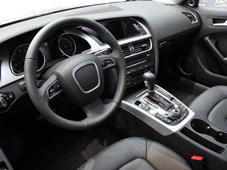Integrating Haptics and Acoustics into Interior Designs for Today’s Sophisticated Drivers
By Eric Grange | July 10, 2017

A blend of consumer demand and elaborate automotive controls has made it imperative for designers and engineers to pay greater attention to the aesthetic characteristics of interior controls. Controls’ look, feel and sound have now become integral to the marketing process for different automotive brands. This mindset shift requires a holistic approach to interface control selection that includes feel and sound characteristics. By integrating haptics (sense of touch) and acoustics (sound perception) into ergonomic and visual design, automotive design engineers can use a vehicle’s interior controls to reinforce the overall brand identity of their vehicles.
The current trend in interface controls has moved to smaller tactile switches with much shorter travel. Short-travel tactile switches usually include a metallic snap dome contact system, which provides the interface between the actuator and the switch housing. Although metallic domes typically have some advantages over their silicon counterparts, such as longer life cycle and a shorter travel, design engineers should keep in mind that the switch will often produce an audible sound when used.
This can be a challenge when trying to create a pleasant, high perceived quality, noise-free environment for the driver, and should take into account to comply with the brand. For example, the sound generated by a tactile switch is a function of several factors: dome composition, structure and design of the switch body, and how the switch fits into the larger system.
It is important for engineers to select the switch structure and materials configurations between haptics targets and actual sound generated to create an environment the driver will appreciate. Engineers can do this by considering the pre-installation response of a switch that may be altered by process parameters (e.g., soldering to the PC board), and by measuring, controlling and maintaining the consistency of sound generated by several tactile switches within the same vehicle post-installation.
Touch screens, or tactile screens, are another design aspect engineers need to consider for modern vehicles. Many premium brands are integrating smartphone displays within the car’s center console, which is an important interface and feature. By combining low-profile tactile switches within a wider actuating superstructure, designers can create a large clickable area that allows the driver to control multiple functions on a single surface, while minimizing power consumption and distractions behind the wheel.
Achieving the exact haptic and acoustic results for automotive interior controls is a complex process in which all steps have their own standing. C&K’s high-quality switches upgrade the life expectancy of applications – including the double-throw and double-pole switches that are so important in creating an ISO 26262-compliant automobile – to help automotive designers meet the expectations of today’s sophisticated and tech-savvy drivers.

Eric Grange
Global Segment Manager
Automotive
